List of Serb countries and regions
The term Serbian lands has been used for medieval Serbian state creations, for Serb-inhabited territories in the Ottoman and Habsburg period (15th–19th century), and in political-geopraphical use[1] since the independence of Serbia and Montenegro. During the Yugoslav wars it was used for the ethnic unification of Serbs through union of Serbia, Montenegro, Republika Srpska and Republic of Srpska Krajina.
History
The "medieval Serbian lands" included Serbian tribes, polities and monarchies, such as Raška, Serbian Empire, etc.[1]
Roots of the Greater Serbian ideology are often traced back to Serbian minister Ilija Garašanin's Načertanije (1844),[2] who envisioned a reconstruction of the Serbian Empire and unification of "Serbian lands", which included Bosnia and Herzegovina, Montenegro, northern Albania, parts of Dalmatia and the Habsburg Military Frontier.[3]
In 1857, while traveling across "Ancient Serbia", Alexander Hilferding (1831-1872), a Russian Slavist and travel writer of German origin, wrote: "an Orthodox Serb, wherever he might live – in Bosnia, Herzegovina, Dalmatia, Hungary, Principality of Serbia – has, besides a church, one great homeland, Serbian land, which is, to tell the truth, divided among many masters, but it exists as an ideal, as the land of the unified Orthodox Serbian nation. He has his own oral tradition, folklore; he knows about Serbian Saint Sava, Serbian Emperor Dušan, Serbian martyr Lazar, popular hero Prince Marko. His current life rests upon the foundations of his nation and it is permeated with the previous historical life of the nation".[4]
The term was used by political theorist Dobrica Ćosić for the ethnic unification of Serbs through union of Serbia, Montenegro, Republika Srpska and Republic of Srpska Krajina during the Yugoslav wars (1991–95).[5]
Middle Ages
| Image | Map | Name | Years | Area | Notes |
|---|---|---|---|---|---|
 |
 |
Serbian Principality | 7th century-969 | Serbia BiH Montenegro Croatia Albania |
Held by the Vlastimirović dynasty. Časlav (r. 927-960) liberated the Serbian principalities from Bulgarian rule in 927. He enlarged Serbia, uniting the tribes of Bosnia, Herzegovina, Old Serbia and Montenegro (incorporated Zeta, Pagania, Zahumlje, Travunia,[6] Konavle, Bosnia and Rascia into Serbia, "ι Σερβλια").[7][8] He took over regions previously held by Michael of Zahumlje, who disappears from sources in 925.[6] De Administrando Imperio describes his realm: the shores of the Adriatic Sea, the Sava river and the Morava valley as well as today's northern Albania.[8] |
 |
 |
Principalities | |||
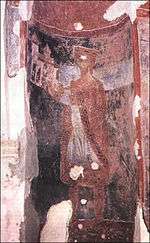 |
 |
Kingdom of Duklja (Doclea) | 1030s-1186 | Serbia BiH Montenegro Croatia Albania |
|
 |
 |
Serbian Grand Principality [Rascia] | 1091-1217 | Serbia BiH Montenegro Croatia Albania Macedonia |
|
 |
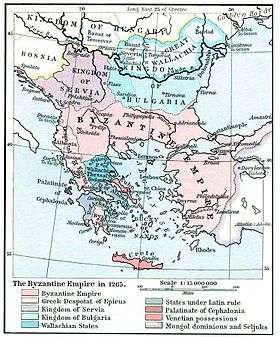 |
Serbian Kingdom | 1217-1345 | Serbia BiH Montenegro Croatia Albania Macedonia |
|
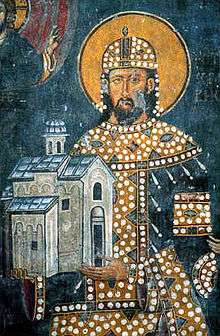 |
 |
Kingdom of Syrmia | 1282–1325 | Serbia BiH |
|
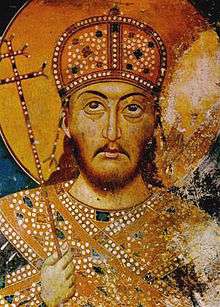 |
 |
Serbian Empire | 1345-1371 | Serbia Macedonia Montenegro Albania Greece Bulgaria |
|
 |
 |
dissolution of Serbian Empire into:
|
|||
 |
 |
Duchy of Saint Sava (till 1449 Duchy of Hum and the Coast) | 1448–1483 | Bosnia and Herzegovina Montenegro Serbia Croatia |
|
.jpg) |
-en.svg.png) |
Serbian Despotate | 1402-1459 (titular Serbian despots existed until 1537 in the medieval Kingdom of Hungary) | Serbia Bosnia and Herzegovina Montenegro Albania |
1526-1918
| Image | Map | Name | Years | Area | Notes |
|---|---|---|---|---|---|
 |
 |
State of Jovan Nenad | 1526-1527 | Serbia Romania Hungary Croatia | |
 |
 |
Duchy of Syrmia of Radoslav Čelnik | 1527–1530 | Serbia Croatia | |
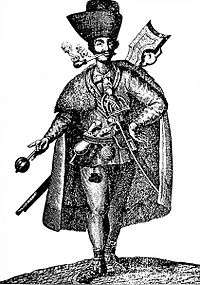 |
Military Frontier | 1579–1882 | Serbia Croatia Romania Hungary | ||
 |
Habsburg Kingdom of Serbia | 1718–1739 | Serbia | ||
 |
New Serbia | 1752–1764 | Ukraine | ||
 |
 |
Slavo-Serbia | 1753–1764 | Ukraine | |
| Koča's Frontier | 1788–1791 | Serbia | |||
 |
 |
Karađorđe's Serbia | 1804–1813 | Serbia Bosnia and Herzegovina Montenegro Bulgaria | |
 |
 |
Princedom of Serbia | 1817–1882 | Serbia | |
 |
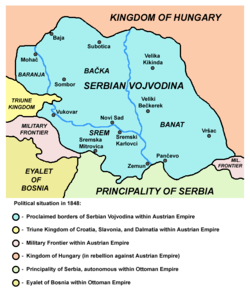 |
Serbian Voivodeship | 1848–1849 | Serbia Croatia Hungary Romania | |
 |
.png) |
Voivodeship of Serbia and Tamiš Banat | 1849–1860 | Serbia Romania Hungary | |
 |
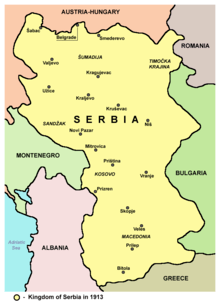 |
Kingdom of Serbia | 1882–1918 | Serbia Republic of Macedonia |
1918-1990s
- State of Slovenes, Croats and Serbs (1918)
- Banat Republic (1918)
- Kingdom of Serbs, Croats and Slovenes (1918–1929), Kingdom of Yugoslavia (1929–1941)
- Banat, Bačka and Baranja (1918–1919)
- Serb-Hungarian Baranya-Baja Republic (1921)
- Kingdom of Serbia (1941–1944)
- Banat (1941–1944)
- Republic of Užice (1941)
- Democratic Federal Yugoslavia (1944–1946), Federal People's Republic of Yugoslavia (1946–1963), Socialist Federal Republic of Yugoslavia (1963–1992)
- People's Republic of Serbia (1944–1963), Socialist Republic of Serbia (1963–1990), Republic of Serbia (1990–1992)
- Autonomous Province of Vojvodina (1944–1963), Socialist Autonomous Province of Vojvodina (1963–1990), Autonomous Province of Vojvodina (1990–1992)
- Autonomous Region of Kosovo and Metohija (1945–1974), Socialist Autonomous Province of Kosovo (1974–1990), Autonomous Province of Kosovo (1990–1992)
- People's Republic of Bosnia and Herzegovina (1945–1963), Socialist Republic of Bosnia and Herzegovina (1963–1990), Republic of Bosnia and Herzegovina (1990–1992)
- People's Republic of Croatia (1945–1963), Socialist Republic of Croatia (1963–1990)
- People's Republic of Serbia (1944–1963), Socialist Republic of Serbia (1963–1990), Republic of Serbia (1990–1992)
1990s
- Republic of the Serbian People of Bosnia and Herzegovina (1992), Serb Republic (1992–1995)
- Autonomous Area of Krajina (1991), Serbian Autonomous Area of Bosnian Krajina (1991–1992)
- Serbian Autonomous Region of North-Eastern Bosnia (1991–1992)
- Serbian Autonomous Region of Romanija (1991–1992)
- Serbian Autonomous Region of Eastern Herzegovina (1991–1992)
- Republic of Serbian Krajina (1991–1995)
- Serbian Autonomous Region of Knin Krajina (1990), Serbian Autonomous Area of Krajina (1990–1991)
- Serbian Autonomous Area of Western Slavonia (1991)
- Serbian Autonomous Area of Eastern Slavonia, Baranja and West Srem (1991), United Nations Transitional Administration for Eastern Slavonia, Baranja and Western Syrmia (1995–1998)
- Dubrovnik Republic
- Federal Republic of Yugoslavia (1992–2003), State Union of Serbia and Montenegro (2003–2006)
- Republic of Serbia (1992–2006)
- Autonomous Province of Vojvodina (1992–2006)
- Autonomous Province of Kosovo and Metohija (1992–1999)
- Republic of Serbia (1992–2006)
Present political entities

This is the list of the current states and regions where Serbs are in absolute or relative ethnic majority, are one of the constitutional or recognized peoples or Serbian language is official:
- Serbia (Serb majority; 83.3% ethnic Serbs)
- Autonomous Province of Vojvodina (Serb majority; 66.76% ethnic Serbs)
- Bosnia and Herzegovina (constitutive nation)
- Republika Srpska (Serb majority; 88% ethnic Serbs)
- Federation of Bosnia and Herzegovina (Serb minority; 3% ethnic Serbs)
- Brčko District (Serb minority; ~40% ethnic Serbs)
- Montenegro (28.7% ethnic Serbs, 42.9% speaks Serbian)
- Croatia (Serb minority; 4%) [9]
- Kosovo (partially recognised state, Serbian minority; 1.5%)
- North Kosovo (region of Kosovo, Serb majority; 95.5%)
- Republic of Macedonia (Serb minority; 1.8%) [9]
Diaspora
- Hungary (minority) [9]
- Albania (minority) [9]
- Romania (minority) [9]
- Slovakia (minority) [9]
- Czech Republic (minority) [9]
See also
| Part of a series of articles on |
| Serbs |
|---|
 |
|
Native communities |
|
Related people |
- Greater Serbia
- List of regions of Serbia
- List of Serbian monarchs
- History of Serbia
- History of Montenegro
- History of Vojvodina
- History of Kosovo
- History of Bosnia and Herzegovina
- History of Republika Srpska
- Republic of Ragusa
References
- 1 2 Vuković & Vemić 2014.
- ↑ Cohen, Philip J.; Riesman, David (1996). Serbia's Secret War: Propaganda and the Deceit of History. Texas A&M University Press. p. 3. ISBN 0-89096-760-1.
- ↑ Balazs Trencsenyi; Michal Kopecek (1 November 2006). National Romanticism: The Formation of National Movements. Central European University Press. pp. 240–. ISBN 978-963-7326-60-8.
- ↑ "Elements Of Ethnic Identification Of The Serbs" (PDF): 727.
- ↑ Dejan Jović (January 2009). Yugoslavia: A State that Withered Away. Purdue University Press. pp. 135–. ISBN 978-1-55753-495-8.
- 1 2 The entry of the Slavs into Christendom, p. 209
- ↑ The early medieval Balkans, p. 160
- 1 2 Južnoslavensko pitanje, p. 48
- 1 2 3 4 5 6 7 "Information on the status of Serbian people in the neighbouring countries, Ministry for Diaspora, Republic of Serbia". Archived from the original on 2007-11-24. Retrieved 2007-05-15.
Sources
- Vuković, Nebojša; Vemić, Mirčeta (1 April 2014), "Position of the Serbian lands", History and geography: meetings and permeations, САНУ, pp. 123–, ISBN 978-86-7005-125-6